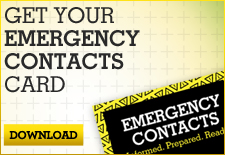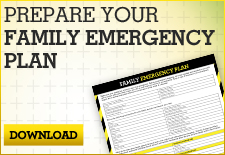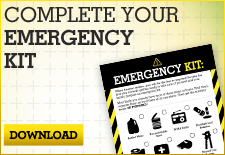
Disasters can happen… at any time. Be prepared to take action before, during and after.
Heat is the number one weather‐related killer in the United States. Heat kills by pushing the human body beyond its limits. In extreme heat and high humidity, evaporation is slowed and the body must work harder to maintain a normal temperature.
Conditions that can induce heat‐related illnesses include poor air quality and little to no air circulation. As a result, people who live in urban areas may be at greater risk from the effects of a prolonged heat wave than those living in rural areas. Also, asphalt and concrete store heat longer and gradually release heat at night, which can produce higher nighttime temperatures.
Your best defense against heat‐related illnesses is prevention. You can be prepared by knowing the symptoms of heat disorders and overexposure to the sun, staying hydrated and being ready to give first aid treatment.
| Condition: | Symptoms: | First Aid Response: |
| Severe Sunburn | • Skin redness • Pain • Possible swelling • Blisters • Fever • Headaches |
• Take a shower • Use soap to clean skin • Apply dry, sterile dressing • Seek medical attention |
| Heat Cramps | • Painful spasms (in legs or abdomen) • Heavy sweating |
• Move to cooler location |
| Heat Exhaustion | • Heavy sweating • May be cool, pale, flushed or have normal body temperature • Fainting, dizziness • Exhaustion • Headaches |
• Lie down • Loosen or remove clothing • Apply cool, wet clothes or towels • Fan or seek air conditioning • Give sips of water if awake • Sips of cool water every 15 minutes • Discontinue liquids if nauseated • Seek immediate medical attention if vomiting begins |
| Heat Stroke |
• High temperature of 103°F+ |
• Danger! Call 9‐1‐1 |
The National Oceanic and Atmospheric Administration (NOAA) can issue the following heat‐related products as conditions warrant. During extreme heat emergencies, you can find detailed information on your local TV and radio, the National Weather Service, and NOAA.
Before
Preparing for extreme heat can protect your family. There are steps you can take to make your home a better place to stay during periods of extreme heat.
2 – Complete the Emergency Contacts Card and place one in your Emergency Kit.
3 – Prepare an Emergency Kit. The Emergency Kit should be easily accessible should you and your family be forced to shelter in place (stay at home) for a period of time.
- Install window air conditioners snugly; insulate if needed.
- Check air conditioning ducts for proper insulation.
- Install temporary window reflectors for use between windows and drapes, such as aluminum foil‐covered cardboard, to reflect heat back outside.
- Weather‐strip doors and sills to keep cool air in.
- Cover windows that receive morning or afternoon sun with drapes, shades, awnings, or louvers. Outdoor awnings or louvers can reduce the heat that enters a home by up to 80 percent.
- Keep storm windows up all year.
During a heat emergency, there are ways that you can protect you and your family from illness and harm.
- Stay indoors as much as possible and limit exposure to the sun.
- Stay on the lowest floor out of the sun if air conditioning is not available. Heat rises.
- Eat well‐balanced, light, and regular meals and avoid salt tablets unless otherwise directed.
- Drink plenty of water. Consult your doctor if you have medical fluid retention issues.
- Limit your intake of alcoholic beverages; they raise your body temperature.
- Dress in baggy, lightweight, and light‐colored clothes that cover as much skin as possible.
- Protect your face and head by wearing a wide‐brimmed hat. Use sunscreen on exposed skin if you have to be outside.
- Avoid hard physical work during the warmest part of the day. Use a buddy system and take frequent breaks.
During and after extreme heat events, remember to check up on family, friends, and neighbors who are alone and do not have air conditioning. If you are 65 years of age or older, have a friend or relative call to check on you twice a day during a heat wave. If you know anyone in this age group, check on them at least twice a day. After extreme heat conditions, it is still likely to be very warm. Continue to hydrate and protect yourself and your family from heat‐related illness.



